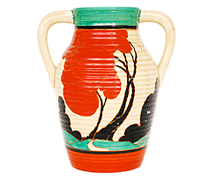Clarice Cliff Feature Articles
As an avid collector of geometric and abstract designs, I have always been intrigued by “Football”. An article and photograph in a back issue of a Review from 1984 first made me aware of the design in 1986, but I had to wait two years before I was able to purchase my first example. “Football” is made up entirely of horizontal and vertical lines and actually has very few elements to it. It appears to be a mass of lines and blocks of colour crossing and intersecting each other when seen on a piece of ware. However, look at fig. 1, and you can see it is a straightforward basic design.
A vase is usually painted as four panels divided by black vertical lines and fig. 2 shows the amount of design visible at any one time on a vase. This is also the amount of design that would be painted on a plate. It is already beginning to look more complex, but the later diagram shows that the basic design merely repeats itself with the panel to the left stepping down and the one to the right stepping up.
As you can see, because it steps it does not match when the first panel (1) joins the last panel (4) - the illustration has been drawn this way to demonstrate this. If panel 1 is placed to the left of panel 2 the pattern is coherent and gradually steps up from left to right. Attempts are sometimes made to tidy up the first and last panel join but usually it is just left as it happens to fall.
As far as I am aware, the actual design was never intentionally offered as an alternative colour way. However, I know of at least one example which has an accidental alternative. The 10-inch plate illustrated on page 10 of “The Bizarre Affair” has been coloured in upside down!
The standard design, if such a thing exists, is of parallel black outlines running horizontally and vertically, filled with green. The horizontal band above the net crosses over the vertical onto the left of the net which then appears to run behind it. The horizontal band above the net is usually wider than the others with the black outline under the band also being thicker. There is a black square which intersects the bottom left hand corner of the net.
There is no standard banding, it comes in many variations of colour, the number of bands and their thicknesses. The design appears to be consistent on most examples but the quality of the painting varies considerably. I have seen two design variations. The first has the design minus the black square which intersects the net; the other has a couple of extra small black squares in the top right corner.
I had eagerly awaited the first illustration of “Football” on a rare and interesting shape, but on receipt of the Wedgwood brochure my first reaction was favourable, but something was wrong. An additional yellow block had been added to one panel. An additional repeat of the pattern including another net added to another panel. The horizontal lines above the net do not intersect the vertical ones. The black outline above the net is not thicker than the rest. This is just on the panels visible in the photograph.
I have sort of come to terms with the Wedgwood colours not being quite right but find it difficult to accept that they could not get the design right. Will I buy one? Probably, unless you have a genuine shape 366 or another piece of “Football” you are looking to sell - contact me if you do!!
(Thanks to Jack for taking the time to write his in-depth observations on one of Clarice’s very intriguing designs, which it appears was not copied from any known source. LG)
The above feature first appeared in a 1993 CCCC Review - DM





